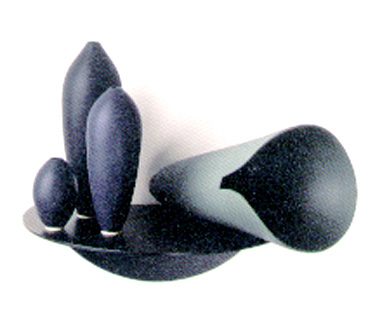
Elsa Rady
American , 1943-
Still Life I, 1991
porcelain on anodized aluminum shelf
SBMA, Museum Purchase, with funds provided by the Twentieth-Century Art Acquisition Fund and an anonymous donor
1993.24a-e
COMMENTS
The exhibition In Dialogue examines the artistic sensibilities Rady and Mapplethorpe shared by presenting her exquisite ceramic sculpture in juxtaposition with his strikingly beautiful photography. Focusing exclusively on the genre of still life as explored in depth by both artists, the selection presents Rady’s delicate groupings of highly refined, monochromatic vessels alongside the meticulously composed and rarefied floral and fruit arrangements by Mapplethorpe. If distinct in terms of medium, these two bodies of work are related in their concern for harmony, balance, symmetry, proportion, measure, and organic unity, attributes that Plato discusses in his Dialogues, the first Western texts of beauty and aesthetics. Central to the “dialogue” prompted by joining together the works of these two contemporary artists is an examination of aesthetics. Convinced of their continuing validity, both Rady and Mapplethjorpe remind us that, despite the theoretical impulse that prevails in postmodernism, aesthetics in contemporary art are neither bankrupt nor obsolete.
The artistic genius that Mapplethorpe recognized in Elsa Rady’s mature work was nascent when she was just s child. Born in New York City in 1943 and raised there during her early years, Rady’s unusual talent led her parents to enroll her, at age 7, in ceramics classes at Greenwich House Pottery on Jones Street. For three years she took courses with her sister Jane and her childhood friend Carol Sackler, whose father, Arthur M. Sackler, was then actively building what would become one of this country’s most distinguished collections of Asian art, much of it devoted to ceramics. Today Rady recalls that it was in the nearby Sackler home that she first saw Sung dynasty ceramics from the twelfth century, not knowing what they were, only that she liked them.
If the Sackler home imprinted fond memories, then Rady’s own environs left an even stronger impression. Her mother, Lily Mehlman Rady, a Martha Graham dancer during the late 1920s and 1930s, was an enormous influence on Elsa, and they enjoyed a powerful mother-daughter relationship. Lily Rady, captivated by the most innovative in streamlined, modern design, surrounded her family with furniture, glassware, tableware, flatware, cookware, and fabrics by such individual designers and design firms as Hugo Alvar Henrik Aalto, Dansk International Designs Ltd., Charles and Ray Eames, Piero Fornasetti, Georg Jensen, Knoll Associates, Inc., Jack Lenor Larsen, Herman Miller, George Nelson, Isamu Noguchi, Orrefors, Gio Ponti, and Philipp Rosenthal. Interspesed were antique furniture and decorative arts of a wide-ranging variety, from early American and Shaker to Louis XIV. Her mother’s quirky eclecticism and inspiring effort to achieve the Bauhaus ideal of weaving art into the fabric of daily life left a lasting mark on the artist.
Rady’s college-level training, in ceramics at Chouinard Art Institute in Los Angeles from 1962 to 1966, where she studied with mentors Ralph Bacerra and Vivika and Otto Heino, was also critical. The school’s advocacy of revolution within tradition urged students to begin with classical ceramic forms and techniques but conclude with fresh interpretations. This explains, in part, Rady’s selection of an ancient form and material—the vessel made of porcelain—as the passionate focus of her artistic activity. Chouinard also required a thorough grounding in the history and techniques of ceramics, providing the artist with a comprehensive knowledge of porcelain in all its facets. It was at Chouinard that she learned about Chinese ceramics, in depth, particularly those of the Sung dynasty which had so impressed her as a child and would serve as an influential source in her mature work.
The foundation for Rady’s mature aesthetic, then rests primarily upon two main spheres of influence—classical Asian ceramics and modern European and American designs. If she finds inspiration in these two vastly different fields of artistic endeavor, how does she view their basic points of aesthetic intersection? Despite the contrast between the two areas of artistic production, she sees correspondences in their use of simplified, unadorned form, attention to materials, refinement of surface, and concern for proportion and composition. “Less is more” is the reigning idea in both domains, a concept with which Rady identifies completely. This defining phrase of modernism, proclaimed by one of the movement’s central figures, Mies van der Rohe, aptly characterizes the aesthetic aims of Rady’s later work as represented in this exhibition. The intricately patterned chinoiserie that she perfected during the late 1960s and 1970s after leaving Chouinard ultimately gave way to a simultaneously rigorous and sensuous minimalism in the 1980s.
Even though the vessel form is Rady’s central motif, it is not functional, nor does it rest conventionally on the table top. Instead, Rady works against type by placing her vessels singly or in combination on the wall and mounting them with bolts to aluminum shelves. She insists on controlling the presentation in a way unthinkable in traditional ceramics, and in so doing, dismantles the distinction between fine and industrial arts. Rady reorders the art hierarchy by inviting multiple readings of her work. “Is it art or craft?” “If it functional or non-functional?” “Is it formal or conceptual?” one asks. If “pure form” is the byword of modernism, “hybrid” serves as the slogan for postmodernism. Rady’s conflation of traditionally opposite characteristics from the realsm of art and craft is a deliberate courting of ambiguity that places her work clearly within contemporary postmodernist practice.
- Transcribed by Ricki Morse, March 2004
